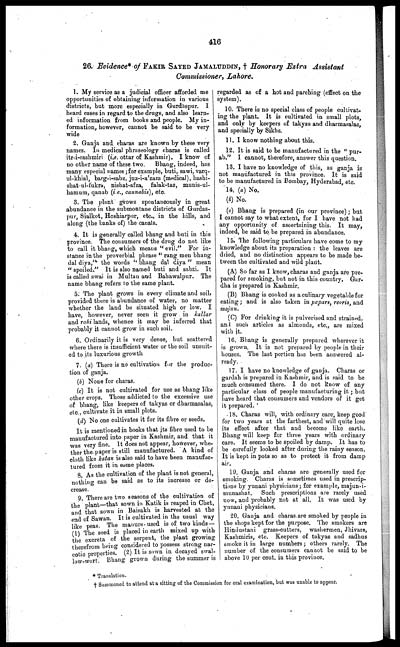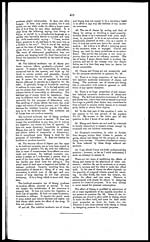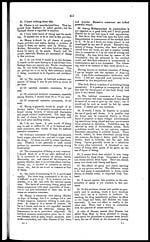Medicine - Drugs > Report of the Indian Hemp Drugs Commission, 1894-1895 > Volume V
(436) Page 416
Download files
Individual page:
Thumbnail gallery: Grid view | List view

416
26. Evidence* of FAKIR SAYED JAMALUDDIN, † Honorary Extra Assistant
Commissioner, Lahore.
1. My service as a judicial officer afforded me
opportunities of obtaining information in various
districts, but more especially in Gurdaspur. I
heard cases in regard to the drugs, and also learn-
ed information from books and people. My in-
formation, however, cannot be said to be very
wide
2. Ganja and charas are known by these very
names. In medical phraseology charas is called
itr-i-cashmiri (i.e. ottar of Kashmir). I know of
no other name of these two. Bhang, indeed, has
many especial names; for example, buti, sawi, varq-
ul-khial, barg-i-sabz, juz-i-a'zam (medical), hashi-
shat-al-fukra, nishat-afza, falak-taz, munis-ul-
hamum, qanab (i.e., cannabis), etc.
3. The plant grows spontaneously in great
abundance in the submontane districts of Gurdas-
pur, Sialkot, Hoshiarpur, etc., in the hills, and
along (the banks of) the canals.
4. It is generally called bhang and buti in this
province. The consumers of the drug do not like
to call it bhang, which means "evil." For in-
stance in the proverbial phrase "rang men bhang
dal diya," the words "bhang dal diya" mean
"spoiled." It is also named buti and sabzi. It
is called swai in Multan and Bahawalpur. The
name bhang refers to the 6ame plant.
5. The plant grows in every climate and soil,
provided there is abundance of water, no matter
whether the land be situated high or low. I
have, however, never seen it grow in kallar
and rohi lands, whence it may be inferred that
probably it cannot grow in such soil.
6. Ordinarily it is very dense, but scattered
where there is insufficient water or the soil unsuit-
ed to its luxurious growth
7. (a) There is no cultivation for the produc-
tion of ganja.
(b)None for charas.
(c)It is not cultivated for use as bhang like
other crops. Those addicted to the excessive use
of bhang, like keepers of takyas or dharmasalas,
etc., cultivate it in small plots,
(d) No one cultivates it for its fibre or seeds.
It is mentioned in books that its fibre used to be
manufactured into paper in Kashmir, and that it
was very fine. It does not appear, however, whe-
ther the paper is still manufactured. A kind of
cloth like katan is also said to have been manufac-
tured from it in some places.
8. As the cultivation of the plant is not general,
nothing can be said as to its increase or de-
crease.
9. There are two seasons of the cultivation of
the plant—that sown in Katik is reaped in Chet,
and that sown in Baisakh is harvested at the
end of Sawan. It is cultivated in the usual way
like peas. The manure used is of two kinds —
(1) The seed is placed in earth mixed up with
the excreta of the serpent, the plant growing
therefrom being considered to possess strong nar-
cotic properties. (2) It is sown in decayed swal-
low-wort. Bhang grown during the summer is
regarded as of a hot and parching (effect on the
system).
10. There is no special class of people cultivat-
ing the plant. It is cultivated in small plots,
and only by keepers of takyas and dharmasalas,
and specially by Sikhs.
11. I know nothing about this.
12. It is said to be manufactured in the "pur-
ab." I cannot, therefore, answer this question.
13. I have no knowledge of this, as ganja is
not manufactured in this province. It is said
to be manufactured in Bombay, Hyderabad, etc.
14. (a) No.
(b) No.
(c) Bhang is prepared (in our province); but
I cannot say to what extent, for I have not bad
any opportunity of ascertaining this. It may,
indeed, be said to be prepared in abundance.
15. The following particulars have come to my
knowledge about its preparation: the leaves are
dried, and no distinction appears to be made be-
tween the cultivated and wild plant.
(A) So far as I know, charas and ganja are pre-
pared for smoking, but not in this country. Gar-
dha is prepared in Kashmir.
(B)Bhang is cooked as a culinary vegetable for
eating; and is also taken in pa pars, reoris, and
majun.
(C)For drinking it is pulverised and strained,
and such articles as almonds, etc., are mixed
with it.
16.Bhang is generally prepared wherever it
is grown. It is not prepared by people in their
houses. The last portion has been answered al-
ready.
17. I have no knowledge of ganja. Charas or
gardah is prepared in Kashmir, and is said to be
much consumed there. I do not know of any
particular class of people manufacturing it; but
have heard that consumers and vendors of it get
it prepared.
18. Charas will, with ordinary care, keep good
for two years at the farthest, and will quite lose
its effect after that and become like earth.
Bhang will keep for three years with ordinary
care. It seems to be spoiled by damp. It has to
be carefully looked after during the rainy season.
It is kept in pots so as to protect it from damp
air.
19.Ganja and charas are generally used for
smoking. Charas is sometimes used in prescrip-
tions by yunani physicians; for example, majun-i-
munashat. Such prescriptions are rarely used
now, and probably not at all. It was used by
yunani physicians.
20. Ganja and charas are smoked by people in
the shops kept for the purpose. The smokers are
Hindustani grass-cutters, washermen, Jhivars,
Kashmiris, etc. Keepers of takyas and sadhus
smoke it in large numbers; others rarely. The
number of the consumers cannot be said to be
above 10 per cent. in this province.
* Translation.
† Summoned to attend at a sitting of the Commission for oral examination, but was unable to appear.
Set display mode to: Large image | Zoom image | Transcription
Images and transcriptions on this page, including medium image downloads, may be used under the Creative Commons Attribution 4.0 International Licence unless otherwise stated. ![]()
| India Papers > Medicine - Drugs > Report of the Indian Hemp Drugs Commission, 1894-1895 > Volume V > (436) Page 416 |
|---|
| Permanent URL | https://digital.nls.uk/75122156 |
|---|
| Description | Volume 5: Evidence of witnesses from North-Western Provinces and Oudh and Punjab. Answers from witnesses in North-Western Provinces, Oudh and Punjab about cultivation and growth of hemp, preparation or manufacture, trade, consumption or use, effects, administration - taxation and control. |
|---|---|
| Attribution and copyright: |
|




